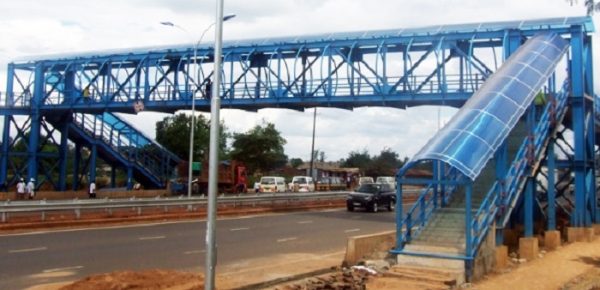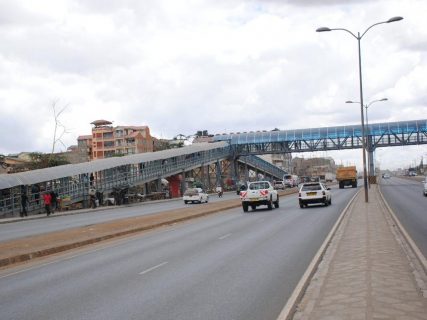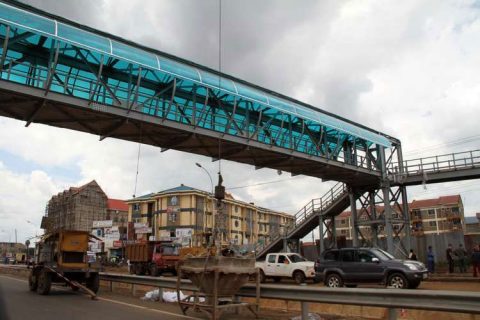At least four new footbridges will be constructed along the Thika Super Highway, according to an order from Transport Cabinet Secretary, Kipchumba Murkomen. The CS claimed that the footbridges’ installation would make it a lot easier to cross the busy highway. They will also reduce the rising number of accidents.
Read also: Kenya seeks funds to finance world’s most expensive footbridges
Murkomen claims that the Juja Highpoint Stage, the Centurion Hotel, the Kihunguro Section, the Juja Mona Park Area, as well as Clay Works/Northlands will all have bridges constructed by the Kenya National Highways Authority.
According to Murkomen, engineering design has been concluded on additional footbridges that will be installed at various Thika Super Highway points.
KURA to hold stakeholder engagement forums to determine more areas to build the footbridges
According to reports, the Kenya Urban Roads Authority (KURA) is currently planning stakeholder engagement forums with the participation of Boda Boda associations, matatu SACCOs, NTSA, area residents, and the area chief on the most important sections.
Determining the precise location to build the two new footbridges is the objective of the public consultations. The installation of footbridges at the Green Valley Estate and Githunguri Primary/Secondary School was suggested by King’ara. According to the MP, a number of residents have perished while crossing a busy road.
Construction will start after stakeholder engagement is complete. It will also be determined by users’ satisfaction with the selected location. It is planned for the above to start during the first quarter of 2023.
More safety measures are taken by the government to reduce accidents along the Thika Super Highway
Simon King’ara, a member of parliament from Ruiru, had asked the CS about the state’s safety measures along Thika Road. Murkomen informed the parliament that the government is taking a number of steps to curb road accidents.
They consist of installing road signs and sensitizing the public and other users about the importance of using designated crossing points and passenger pickup and drop-off locations.
The government is improving road bump marking. He noted that this is expected to improve road user safety. He added that additional lighting had been installed to improve security. They are also encouraging people to consistently use the footbridges.
To make sure that pedestrians use designated crossing points, PBC (performance-based contracting) contractors have erected fencing along the median of the highway in critical areas.
The CS stated that the highway patrols, which are carried out by road maintenance contractors engaged by KeNHA under the performance-based contracting approach, have encouraged the drivers of public service vehicles to pick up and drop off passengers at the designated points.
KeNHA and the National Transport and Safety Authority (NTSA) have already made preparations to jointly undertake more public education campaigns. This is meant to prevent lives from being endangered.
Nairobi-Thika Road Expansion project overview
Due to the successful completion of the road, commuters are enjoying faster, more reliable, more comfortable, and more affordable journeys.
The 50km, KES 35 billion (US$ 418 million) Nairobi -Thika Superhighway, officially opened in November 2012 by former President Kibaki, will contribute greatly to transforming Kenya into a strong economic hub for the region and beyond.
The transformation of the road into a super highway is one of Kenya’s first large-scale transportation infrastructure projects.
The Government of Kenya through the Kenya National Highway Authority (KeNHA) embarked on a grand project to have the Nairobi to Thika road expanded from a four-lane highway to an eight-lane superhighway.
The road, which is part of the classified international trunk road A2, originates in downtown Nairobi and extends to Moyale at the Ethiopian border. It is also an important link on the Great North Trans African highway -that traverses from Cape Town in South Africa to Cairo in Egypt- one of the highest priorities in the NEPAD short-term action plan.
The highway had earlier been constructed to bitumen standard in the early 1970s and re-sealed with an overlay in the early 1990s. After rigorous feasibility and capacity studies, it was esteemed to be operating beyond capacity, carrying more than 60,000 vehicles per day. Due to this stress on the road surface, its condition deteriorated rapidly, thus requiring rehabilitation and a redesign to factor in the increased traffic along the route.
The initial planning and diagnostic studies of the inadequacies of the road were done within the context of the Nairobi Metropolitan Area Urban Transport Plan (NMUPT). The study was commissioned by the Government in 2004 with funding from Japan International Cooperation Agency (JICA).
The findings highlighted the inadequate urban transportation infrastructure and system with particular mention of the extremely poor service level and shortage of capacity along the Nairobi-Thika corridor. The section that was earmarked for expansion serves traffic from the built-up areas of Kiambu, Muthaiga, Kasarani and its environs, Kahawa and its environs, Pangani, Ngara, Thika, Juja, Muranga, and beyond.
FINANCIERS
In 2007, the government solicited financial assistance from the Tunis-based African Development Bank (AfDB) Group, which gave a nod following an appraisal of the project in the same year.
Lot 1 and Lot 2 were jointly financed by an AfDB (African Development Bank) loan and grant, and the Government of Kenya. Lot 3 has been financed by the EXIM Bank of China and the Government of Kenya.
Objectives of the project
The overall objectives of the project are to improve road transport services along the Nairobi-Thika corridor and enhance urban mobility by reducing traffic congestion and enhance the accessibility, affordability, and reliability of the transport infrastructure system to promote socio-economic development of the country.
Moreover, the objective of the project is to contribute to the development of a sustainable urban public transit system for the Nairobi Metropolitan Area, improve land transport between Kenya and Ethiopia and contribute to regional integration, promote private sector participation in the management, operation, and financing of road infrastructure in Kenya
Implementation of the Project
To accommodate the existing and future traffic, the highway was redesigned to include the construction of additional lanes, strengthening of existing carriageway, underpass, and overpass in some sections, and removal of intersections at several locations to be replaced by interchanges.
The contract for its improvement was divided into three lots to heighten its implementation. Lot 1 comprised three cities’ arterial connectors the first of which ran from Museum Hill Interchange through Forest Road to Muthaiga. The works involved widening Forest Road to six lanes from four lanes, widening Museum Hill road to six lanes, and provision of fly-over on Limuru Road.
Connector 2 ran from University way, through Pangani to end at Muthaiga. The works involved widening University Way to eight lanes from six, constructing a four-lane flyover across Globe Roundabout, widening Murang’a Road to six lanes, an underpass, overpass, and footbridge at Pangani and an interchange to replace the Muthaiga roundabout.
Lastly, connector 3 ran from Haile Selassie Avenue – Race course road & Ring Road Ngara from Uhuru Highway to Pangani Interchange.
Lot 2 on the other hand, (Muthaiga roundabout-Kenyatta University (KU) section) was designed as a high-speed highway with limited access and exits. The improvements in this section included widening the carriageway to eight lanes- (between Muthaiga and Kasarani) and 6 lanes (from Kasarani to Kenyatta University).
Lot 3, starting from Kenyatta University-Thika. The works involved widening the carriageway to six lanes up to Juja and maintaining the existing provision of service roads, construction of a flyover at the Eastern Bypass, and an underpass at Ruiru sports club.
The project also provides service roads intermittently, construction of underpasses at Kahawa and KU, provision of the interchange at the former GSU roundabout, flyovers at Kasarani and Githurai roundabouts, underpass at former Nakumatt Thika Road site and a subway at Survey of Kenya.
The entire project has provided for 18 pedestrian crossings. The crossings are strategically located around highly built areas where there are a lot of crossings by pedestrians crossing points have facilities to accommodate persons with disabilities.
To enhance road safety, the project has installed gantry road signs, Flexi beam guard rails, world-class road markings, and other road furniture. The project has employed the use of non-scrap value fiber for the road signs on a pilot basis. The public has been urged to desist from vandalizing these facilities.
As part of the initiative to go green, solar-powered street lights have been installed on a pilot basis along Forest Road. Further, comprehensive landscaping has been carried out to make the road aesthetically appealing. The works were implemented in 3 three Contract Lots:
Benefits of the Project
The main beneficiaries are predominantly the people living along the route, especially commuters who work in secondary and tertiary sectors in the Central Business District. The majority of commuters use public transportation especially small minibusses (Matatus) which account for more than 30 percent of traffic congestion in the city.
Over 89,500 people residing in Kasarani, Kiambu, and Thika are on wage employment and another 125,000 are in the informal sector the majority of whom have to commute to Nairobi. Other distinct groups of commuters are students, health patients, shoppers, and traders (formal and informal).
There are 2 public universities established along the road, Kenyatta University and Jomo Kenyatta University of Agricultural Technology (JKUAT) with several students who attend part-time programs, and who will greatly benefit from an efficient transportation system.
Currently, due to the successful completion of the road, commuters are enjoying faster, more reliable, more comfortable, and more affordable journeys. The journey between the two towns that hitherto used to take 2 to 3 hours can now be tacked in 30-45 minutes.
The impact is also realized beyond the project route on the entire A2 as you travel towards Isiolo, Marsabit, Moyale, and into Ethiopia, being part of the multinational Great North Road. The project is also important for enhancing regional growth and integration. It also connects to the main Northern Corridor that runs from Mombasa-Uganda-DRC at the Museum Hill Interchange.
In addition, the corridor doubles as one of the most important economic corridors and will have an impetus for the growth of the country.
As conceptualized in the feasibility and detailed engineering project report, lots of development in the form of Real Estate, industrial expansion, agricultural growth, learning institutions, etc. are already being witnessed.
The construction of an access-control corridor has not only reduced road congestion remarkably but also reduced pollution resulting from vehicle fumes emissions.
ARCHITECTS
CONTRACTORS: LOT 1: M/S China Wu Yi Company Ltd.
LOT 2: M/S Synohydro Corporation Ltd.
LOT 3: M/S Shengli Engineering Construction Group Co. Ltd.
PROJECT MANAGER: Apec Consulting Engineers
PROJECT DURATION: 2009-2012
Reported earlier
April 2018
Construction of footbridges on Thika Superhighway kicks off

Construction work has kicked off on four additional footbridges on the Thika Superhighway in Nairobi, Kenya. Currently, the superhighway has 18 existing footbridges and the additional four will enhance the safety of pedestrians when speed bumps are removed. The project is estimated to cost US $8.2m.
The project contract has been awarded to Interways Works Limited and Fourways Construction Limited. This is according to Peter Mundinia, Director-General of the Kenya National Highway Authority (Kenha).
The footbridges are being erected at the Mang’u area, Witeithie, Garden Estate Junction, and Survey of Kenya just before the junction to the Kenya School of Monetary Studies (KSMS). According to Peter Mundinia, Interways Works Limited is constructing Witeithie and Mangu footbridges at a cost of US $4.3m while Fourway Construction Limited is constructing KSMS and Garden City footbridges at a cost of US $3.9m.
The safety bumps installed on the highway will be removed once the footbridges are complete in a quest to ease traffic.
Also read: Kenya National Highway Authority invites bids for several maintenance road works
Speed limits and signage
Installation of speed limits and signage along the superhighway has commenced in a bid to reduce accidents and promote the safety of motorists and pedestrians. Erection of speed limits and other directional signs will cover the section from Museum Hill interchange to Thika.
“The new signage will replace previous ones either vandalized or knocked down by motorists,” said Mr. Mundinia. “The new signage is part of our efforts to reduce accidents along the busy superhighway, and to promote the safety of both motorists and pedestrians,” he added.
Motorists will face fines of up to US $100 should they exceed the speed limits on the traffic signs.
Jan 2019
Kenya’s US $8m footbridges on Thika Highway to be complete soon

Construction works on the US 8m footbridges on the Thika Highway are soon to be completed. This is according to the Kenya National Highway Authority (Kenha).
Kenha Director General Peter Mundinia said construction of the four footbridges which has been ongoing for the past year, aims at reducing pedestrian fatalities on the busy road. They are being built at Survey of Kenya, the Garden Estate Junction, Witeithie, and Mang’u areas.
“We are still on the timelines and expect to finish by June. People may not understand this because steel bridges are being done in China. They will arrive in March as we fix them,” said Peter Mundinia.
Also Read:Nigeria inaugurates 5.5km road project
High court rule
Over the past years, unnecessary deaths have been caused due to a lack of adequate footbridges as pedestrians are hit by vehicles as they cross the highway, especially at night. The Director General said that the footbridges once complete, will reduce such accidents.
“In the meantime, we have clearly marked areas where the public can cross. Once the superstructures are in place in the next three months, no more pedestrian fatalities will be witnessed on this road,” said.
Aug 2019
Installation of footbridges on Kenya’s Thika Highway to be completed in two months

Installation of pedestrian footbridges along Thika Highway is set to be completed in the next two months according to The Kenya National Highways Authority (KeNHA) Director-General Peter Mundinia.
KeNHA says two footbridges to be installed on Thika Highway will arrive this month as they had opted to have the bridges welded in China, therefore, delaying the scheduled completion date of June 2019.
“Footbridges for the Mang’u area and Witeithie will arrive later this month while the rest will arrive in about two months and once they are in the country, the installation will be done immediately,” said Mundinia.

